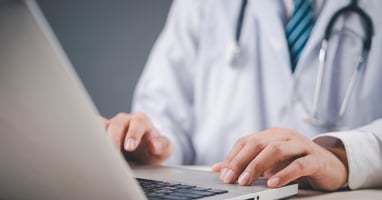A complete view of the employee for the occupational health nurse at a glance. The OH360 program...
Finnish research and technology drive healthcare forward
At the Future Health 2025 event at Terkko Health Hub, the discussion focused on leveraging research, innovation, and health data to enhance the impact and continuity of personalized care.
.png?width=960&height=502&name=Artikkelikuvia%20HippocrAItesille%20(2).png)
Front row from left: Pekka Honkanen, Frank Emmert-Streib, Merja Laine, and Mariella Särestöniemi.
Back row from left: Jari Vuorinen, Peter Nyman, Tero Nyman, and Johan Bolsenbroek.
Open Banking inspires the development of Hippo Health Account
“In Finland, patient data is still fragmented, and care teams spend valuable time searching for information.”
Pekka Honkanen, Chair of the Board and co-founder of HippocrAItes, fell seriously ill 2.5 years ago. The experience revealed a harsh truth from the patient’s perspective: forming a comprehensive view of an individual's health is challenging—even for healthcare professionals.
“In Finland, patient data is still fragmented, and care teams spend valuable time searching for information. Hippo Health Account consolidates an individual’s health data, and Hippo Clinic provides the care team with a clear view. This accelerates decision-making and enables more personalized care—exactly the direction the EHDS regulation is guiding us toward,” Honkanen explains.
Hippo Health Account is a long-term, patient-managed view of personal health data, from which individuals can share relevant information with their care team upon consent. The Hippo Health Account contains the most comprehensive health data package on the market. The solution is officially registered for use by social and healthcare providers under Valvira’s A1 classification. Read more
Honkanen compares the current state of healthcare to the evolution of the banking sector. Just as the Open Banking model enabled customers to access data from multiple banks through a single app, the Hippo Health Account offers patients a unified view of their health data—enabled by interoperable systems, standards, and regulation. The goal is not to replace existing systems but to integrate the data they contain into a functional whole. “The user interface is just the tip of the iceberg. Real impact comes from the patient’s own long-term health history—the complete picture that Hippo Health Account makes visible,” Honkanen emphasizes.
HippocrAItes’ solution is based on the concept of a digital twin—a personalized health account that combines data from EHR systems, health apps, and smart devices. This creates a real-time, holistic view of an individual’s health, which the patient can manage and share as they choose. “This is the essence of data-driven medicine: when information is available at the right time, care becomes faster and more effective,” Honkanen adds.
European Health Data Space brings clarity to health data use
Markus Kalliola, Program Director at Sitra, presented the European Health Data Space (EHDS) regulation, which introduces unified rules for managing health data across the EU. For citizens, this means the right to access their health data digitally and free of charge. For healthcare systems, it introduces mandatory interoperability requirements and enables cross-border data exchange.
Kalliola highlighted Hippo Health Account as an example, which consolidates a patient’s health data into a single view based on interoperable systems and standards — a solution that brings to life EHDS’s goal of unified health data management across the EU.
EHDS covers both primary use of health data for patient care and secondary use for research and innovation. Kalliola emphasizes Finland’s active role in shaping and implementing EHDS, including through the TEHDAS2 and VALO initiatives.
Managing chronic conditions with Hippo Clinic
Diabetologist and Associate Professor Merja Laine explained how diabetes care is being improved by leveraging up-to-date, integrated health data to support continuous care. She introduced Hippo Clinic, a professional interface that allows care teams to monitor patient basics, medications, lab results, diagnoses and allergies in near real-time.
Laine serves as Medical Advisor at HippocrAItes and leads the DiabetesCare360 Development Program, which uses health data to improve diabetes treatment outcomes.
Currently, patient data is often fragmented across systems. “A clear and easily accessible health data view supports clinical decision-making, simplifies care planning, and frees up time for patient interaction and personalized care,” Laine concludes.
Technology as an enabler of remote services
Tero Nyman, CEO of Medics24, and Jari Vuorinen, Chair of TYKY-Klinikka and expert in medical devices, are jointly developing remote and work ability services for companies. Their presentation emphasized a practical approach to healthcare digitalization and remote service development.
“We will have digital health companions that understand your individual needs.”
AI analyzes data from devices and highlights anomalies, allowing doctors to focus on what matters. In the future, smart solutions will increasingly support individual well-being. “Your digital companion might remind you: "Hey, slow down! Have you remembered to eat healthily and get enough rest?", Vuorinen illustrates.
Nyman noted a shift from disease treatment to health promotion, with a focus on prevention and well-being. “Our mission is to bring good into the world: healthier, more productive employees who also thrive outside of work,” Vuorinen adds.
Data-driven medicine and deeper understanding of patient groups
Professor Frank Emmert-Streib describes how medicine is moving from population-level models to individualized, data-driven care, where computational methods, population biology, and patient data support medical research and treatment.
“If a patient experiences unusual symptoms, AI can match this data with thousands of other cases and suggest treatments that have worked in similar situations.”
In the future, patients will be viewed as part of a larger whole, with genetic, biological, and behavioral data combined and analyzed. “The goal is to identify small but meaningful patient groups for targeted treatment and monitoring,” Emmert-Streib says.
Digital twins enable virtual simulations of treatment scenarios, testing of medications and methods, and long-term monitoring. Emmert-Streib likens digital twins to Matryoshka dolls—composed of many layers representing different health aspects. These models help simulate treatment responses and identify limitations, moving medicine toward more personalized solutions.
His talk sparked discussion on how improved access to health data for research will accelerate the development of individualized, data-driven medicine. Participants highlighted the role of EHDS and its practical applications: patient-specific data views and interoperable technologies.
Digital and Physical Twins for personalized health monitoring
Adjunct Professor Mariella Särestöniemi presented the potential of digital and physical twins in personalized health monitoring.
Digital twins are individualized health data models that combine a patient’s measurement data, health records, and everyday needs. They enable prediction of treatment responses, monitoring of disease progression, and tailoring of care on a personal level.
Physical twins are tangible three-dimensional models that replicate a patient’s anatomy. They allow realistic testing of new medical devices and technologies already during the design phase, as well as treatment methods, and enable monitoring of recovery from conditions such as cancer or cranial injuries even outside the hospital environment.
Särestöniemi’s multidisciplinary background in research, health sciences, and technology is reflected in the concrete solutions developed together with various researchers at the University of Oulu in collaboration with clinicians.
- Radiation therapy monitoring: Wireless, wearable devices enable safe and more frequent monitoring of tumor size during treatment.
- Breast cancer monitoring: Sensors integrated into bra-like wearables complement traditional methods by providing a safe and rapid measurement approach, allowing detection of tumors even in dense breast tissue and thus supporting earlier response to treatment needs.
- Monitoring cranial fractures: Portable devices are suitable for both ambulance and child health clinic use, promoting equal access to care even in remote areas.
Särestöniemi emphasizes that technology alone is not enough — individualized monitoring also requires an understanding of each user’s unique characteristics. “Every planned method and device undergoes realistic modeling using various digital and physical twins to ensure it works in real patient scenarios,” Särestöniemi explains.
Thank you to all Future Health speakers and attendees!
.png?width=1200&length=1200&name=Future%20Health%202025_Article_Keynotes%20(8).png)

.png?width=1200&length=1200&name=Future%20Health%202025_Article_Keynotes%20(2).png)
%20%E2%80%93%20kopio.png?width=1200&length=1200&name=Future%20Health%202025_Article_Keynotes%20(3)%20%E2%80%93%20kopio.png)
%20%E2%80%93%20kopio.png?width=1200&length=1200&name=Future%20Health%202025_Article_Keynotes%20(4)%20%E2%80%93%20kopio.png)
%20%E2%80%93%20kopio.png?width=1200&length=1200&name=Future%20Health%202025_Article_Keynotes%20(5)%20%E2%80%93%20kopio.png)
%20%E2%80%93%20kopio.png?width=1200&length=1200&name=Future%20Health%202025_Article_Keynotes%20(6)%20%E2%80%93%20kopio.png)
Would you like to try Hippo Health Account? Get in touch, and we’ll arrange a demo so you can explore the solution in practice!
Didn’t make it to this year’s event?
Join us at the Future Health event in 2026! Register now to secure your spot—places fill up quickly. We’ll keep you updated on the program and speakers.
Future Health is HippocrAItes’ annual event that brings together healthcare professionals, regulatory experts, and technology developers to discuss the future of data-driven, continuous, and personalized care.

.png?height=200&name=Artikkelikuvia%20HippocrAItesille%20(3).png)
